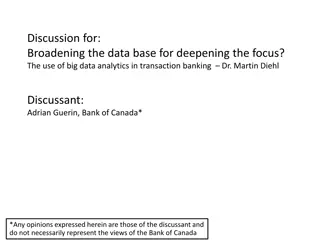
MapReduce: Big Data Processing with Hadoop
Learn the basics of MapReduce and Hadoop for processing big data efficiently. Explore how MapReduce runs on clusters, the roles of Map and Reduce functions, and the benefits of distributed processing. Dive into the world of data analytics with this comprehensive guide.
Download Presentation

Please find below an Image/Link to download the presentation.
The content on the website is provided AS IS for your information and personal use only. It may not be sold, licensed, or shared on other websites without obtaining consent from the author. If you encounter any issues during the download, it is possible that the publisher has removed the file from their server.
You are allowed to download the files provided on this website for personal or commercial use, subject to the condition that they are used lawfully. All files are the property of their respective owners.
The content on the website is provided AS IS for your information and personal use only. It may not be sold, licensed, or shared on other websites without obtaining consent from the author.
E N D
Presentation Transcript
Sreenivasa Institute of Technology and Management Studies (Autonomous) Murukambattu, Chittoor Big Data Analytics 20MCA213 Mrs. R.Padmaja Assistant Professor MCA Department SITAMS UNIT - III
UNIT III - Writing Hadoop MapReduce Programs 1) Understanding the basics of MapReduce 2) Introducing Hadoop MapReduce 2.1) Listing Hadoop mapReduce entities 2.2) Understanding the Hadoop MapReduce scenario 3) Understanding the limitations of MapReduce, 4) Writing a Hadoop MapReduce example 5) Understanding the steps to run a MapReduce job.
1) Understanding the basics of MapReduce To process Big Data with tools such as R and several machine learning techniques requires a high-configuration machine, but that's not the permanent solution. So, distributed processing is the key to handling this data. This distributed computation can be implemented with the MapReduce programming model.
MapReduce implementation runs on large clusters with commodity hardware. This data processing platform is easier for programmers to perform various operations. The system takes care of input data, distributes data across the computer network, processes it in parallel, and finally combines its output into a single file to be aggregated later. This is very helpful in terms of cost and is also a time-saving system for processing large datasets over the cluster. Also, it will efficiently use computer resources to perform analytics over huge data.
For MapReduce, programmers need to just design/migrate applications into two phases: Map and Reduce. They simply have to design Map functions for processing a key-value pair to generate a set of intermediate key-value pairs, and Reduce functions to merge all the intermediate keys. Both the Map and Reduce functions maintain MapReduce workflow. The Reduce function will start executing the code after completion or once the Map output is available to it. Their execution sequence can be seen as follows:
A distributed filesystem spreads multiple copies of data across different machines. This offers reliability as well as fault tolerance. If a machine with one copy of the file crashes, the same data will be provided from another replicated data source. The master node of the MapReduce daemon will take care of all the responsibilities of the MapReduce jobs, such as the execution of jobs, the scheduling of Mapers, Reducers, Combiners, and Partitioners, the monitoring of successes as well as failures of individual job tasks, and finally, the completion of the batch job. Companies using MapReduce include: Amazon: This is an online e-commerce and cloud web service eBay: This is an e-commerce portal for finding articles by its description Google: This is a web search engine for finding relevant pages relating to a particular topic LinkedIn: This is a professional networking site for Big Data storage and generating personalized recommendations Trovit: This is a vertical search engine for finding jobs that match a given description Twitter: This is a social networking site for finding messages
2.1) Listing Hadoop mapReduce entities The following are the components of Hadoop that are responsible for performing analytics over Big Data: 1) Client: This initializes the job 2) JobTracker: This monitors the job 3) TaskTracker: This executes the job 4) HDFS: This stores the input and output data
2.2) Understanding the Hadoop MapReduce scenario The four main stages of Hadoop MapReduce data processing are as follows: 1) The loading of data into HDFS 2) The execution of the Map phase 3) Shuffling and sorting 4) The execution of the Reduce phase
1) The loading of data into HDFS The input dataset needs to be uploaded to the Hadoop directory so it can be used by MapReduce nodes. Then, Hadoop Distributed File System (HDFS) will divide the input dataset into data splits and store them to DataNodes in a cluster by taking care of the replication factor for fault tolerance. All the data splits will be processed by TaskTracker for the Map and Reduce tasks in a parallel manner. Also, there are some alternative ways to get the dataset in HDFS with Hadoop components: 1) Sqoop 2) Flume
Sqoop This is an open source tool designed for efficiently transferring bulk data between Apache Hadoop and structured, relational databases. Suppose your application has already been configured with the MySQL database and you want to use the same data for performing data analytics, Sqoop is recommended for importing datasets to HDFS. Also, after the completion of the data analytics process, the output can be exported to the MySQL database. Flume This is a distributed, reliable, and available service for efficiently collecting, aggregating, and moving large amounts of log data to HDFS. Flume is able to read data from most sources, such as log files, sys logs, and the standard output of the Unix process.
2) Executing the Map phase Executing the client application starts the Hadoop MapReduce processes. The Map phase then copies the job resources (unjarred class files) and stores it to HDFS, and requests JobTracker to execute the job. The JobTracker initializes the job, retrieves the input, splits the information, and creates a Map task for each job. The JobTracker will call TaskTracker to run the Map task over the assigned input data subset. The Map task reads this input split data as input (key, value) pairs provided to the Mapper method, which then produces intermediate (key, value) pairs. There will be at least one output for each input (key, value) pair.
The list of (key, value) pairs is generated such that the key attribute will be repeated many times. So, its key attribute will be re-used in the Reducer for aggregating values in MapReduce. As far as format is concerned, Mapper output format values and Reducer input values must be the same. After the completion of this Map operation, the TaskTracker will keep the result in its buffer storage and local disk space (if the output data size is more than the threshold).
3) Shuffling and sorting To optimize the MapReduce program, this intermediate phase is very important. As soon as the Mapper output from the Map phase is available, this intermediate phase will be called automatically. After the completion of the Map phase, all the emitted intermediate (key, value) pairs will be partitioned by a Partitioner at the Mapper side, only if the Partitioner is present. The output of the Partitioner will be sorted out based on the key attribute at the Mapper side. Output from sorting the operation is stored on buffer memory available at the Mapper node, TaskTracker. The data returned by the Combiner is then shuffled and sent to the reduced nodes. To speed up data transmission of the Mapper output to the Reducer slot at TaskTracker, you need to compress that output with the Combiner function. Bydefault, the Mapper output will be stored to buffer memory, and if the output size is larger than threshold, it will be stored to a local disk.
4) Reducing phase execution As soon as the Mapper output is available, TaskTracker in the Reducer node will retrieve the available partitioned Map's output data, and they will be grouped together and merged into one large file, which will then be assigned to a process with a Reducer method. Finally, this will be sorted out before data is provided to the Reducer method. The Reducer method receives a list of input values from an input (key, list (value)) and aggregates them based on custom logic, and produces the output (key, value) pairs. Reducing input values to an aggregate value as output. The output of the Reducer method of the Reduce phase will directly be written into HDFS as per the format specified by the MapReduce job configuration class.
3) Understanding the limitations of MapReduce Let's see some of Hadoop MapReduce's limitations: The MapReduce framework is notoriously difficult to leverage for transformational logic that is not as simple, for example, real-time streaming, graph processing, and message passing. Data querying is inefficient over distributed, unindexed data than in a database created with indexed data. However, if the index over the data is generated, it needs to be maintained when the data is removed or added. We can't parallelize the Reduce task to the Map task to reduce the overall processing time because Reduce tasks do not start until the output of the Map tasks is available to it. (The Reducer's input is fully dependent on the Mapper's output.) Also, we can't control the sequence of the execution of the Map and Reduce task.
4) Writing a Hadoop MapReduce example Hadoop MapReduce WordCount example is a standard example where hadoop developers begin their hands-on programming with. Hadoop WordCount operation occurs in 3 stages 1) Mapper Phase 2) Shuffle Phase 3) Reducer Phase 1) Mapper Phase The text from the input text file is tokenized into words to form a key value pair with all the words present in the input text file. The key is the word from the input file and value is 1 . For instance if you consider the sentence An elephant is an animal . The mapper phase in the WordCount example will split the string into individual tokens i.e. words. In this case, the entire sentence will be split into 5 tokens (one for each word) with a value 1 as shown below
Key-Value pairs from Hadoop Map Phase Execution- (an,1) (elephant,1) (is,1) (an,1) (animal,1) 2) Shuffle Phase Execution After the map phase execution is completed successfully, shuffle phase is executed automatically wherein the key-value pairs generated in the map phase are taken as input and then sorted in alphabetical order. After the shuffle phase is executed from the WordCount example code, the output will look like this (an,(1,1)) (animal,1) (elephant,1) (is,1)
3) Reducer Phase Execution In the reduce phase, all the keys are grouped together and the values for similar keys are added up to find the occurrences for a particular word. It is like an aggregation phase for the keys generated by the map phase. The reducer phase takes the output of shuffle phase as input and then reduces the key-value pairs to unique keys with values added up. In our example An is the only word that appears twice in the sentence. After the execution of the reduce phase of MapReduce WordCount example program, appears as a key only once but with a count of 2 as shown below - (an,2) (animal,1) (elephant,1) (is,1)
5) Understanding the steps to run a MapReduce job. Steps 1) Open Eclipse> File > New > Java Project >( Name it MRProgramsDemo) > Finish. 2) Right Click > New > Package ( Name it - PackageDemo) > Finish. 3) Right Click on Package > New > Class (Name it - WordCount). 4) Add Following Reference Libraries: Right Click on Project > Build Path> Add External /usr/lib/hadoop-0.20/hadoop-core.jar Usr/lib/hadoop-0.20/lib/Commons-cli-1.2.jar
5) Type the following code: package PackageDemo; import java.io.IOException; import org.apache.hadoop.conf.Configuration; import org.apache.hadoop.fs.Path; import org.apache.hadoop.io.IntWritable; import org.apache.hadoop.io.LongWritable; import org.apache.hadoop.io.Text; import org.apache.hadoop.mapreduce.Job; import org.apache.hadoop.mapreduce.Mapper; import org.apache.hadoop.mapreduce.Reducer; import org.apache.hadoop.mapreduce.lib.input.FileInputFormat; import org.apache.hadoop.mapreduce.lib.output.FileOutputFormat; import org.apache.hadoop.util.GenericOptionsParser;
public class WordCount { public static void main(String [] args) throws Exception { if (args.length != 2) { System.err.println("Insufficient args"); System.exit(-1);} Configuration conf = new Configuration(); conf.set("ResourceManager", "hdfs://192.168.14.128:8050"); Job job = new Job(conf, "WordCount"); job.setJarByClass(WordCount.class); // class conmtains mapper and job.setMapOutputKeyClass(Text.class); // map output key class job.setMapOutputValueClass(IntWritable.class);// map output value class job.setOutputKeyClass(Text.class); // output key type in reducer job.setOutputValueClass(IntWritable.class);// output value type in job.setMapperClass(WordCountMapper.class); job.setReducerClass(WordCountReducer.class); job.setInputFormatClass(TextInputFormat.class); // default inputkey job.setOutputFormatClass(TextOutputFormat.class); FileInputFormat.addInputPath(job, new Path(args[0])); FileOutputFormat.setOutputPath(job, new Path(args[1])); job.waitForCompletion(true); }
public static class WordCountMapper extends Mapper<LongWritable, Text, Text, IntWri table> { public void map(LongWritable key, Text value, Context con) throws IOExcepti on, InterruptedException { String line = value.toString(); String[] words=line.split(","); for(String word: words ) { Text outputKey = new Text(word.toUpperCase().trim()); IntWritable outputValue = new IntWritable(1); con.write(outputKey, outputValue); } } }
public static class WordCountReducer extends Reducer<Text, IntWritable, Text, IntWri table> { public void reduce(Text word, Iterable<IntWritable> values, Context con) thro ws IOException, InterruptedException { int sum = 0; for(IntWritable value : values) { sum += value.get(); } con.write(word, new IntWritable(sum)); } } }
The above program consists of three classes: 1) Driver class (Public, void, static, or main; this is the entry point). 2) The Map class which extends the public class Mapper<KEYIN,VALUEIN,KEYOUT,VALUEOUT> and implements the Map function. 3) The Reduce class which extends the public class Reducer<KEYIN,VALUEIN,KEYOUT,VALUEOUT> and implements the Reduce function.
6) Make a jar file Right Click on Project> Export> Select export destination as Jar File > next> Finish.
7) Take a text file and move it into HDFS format: To move this into Hadoop directly, open the terminal and enter the following commands: [training@localhost ~]$ hadoop fs -put wordcountFile wordCountFile
8) Run the jar file: syntax : (Hadoop jar jarfilename.jar packageName.ClassName PathToInputTextFile PathToOutputDirectry) command : [training@localhost ~]$ hadoop jar MRProgramsDemo.jar PackageDemo.Wor dCount wordCountFile MRDir1 9) Open the result: [training@localhost ~]$ hadoop fs -ls MRDir1 Found 3 items -rw-r--r-- 1 training supergroup 0 2016-02-23 03:36 /user/training/MRDir1/_SUCCESS drwxr-xr-x - training supergroup 0 2016-02-23 03:36 /user/training/MRDir1/_logs -rw-r--r-- 1 training supergroup 20 2016-02-23 03:36 /user/training/MRDir1/part-r-00000
[training@localhost ~]$ hadoop fs -cat MRDir1/part-r-00000 BUS 7 CAR 4 TRAIN 6





















